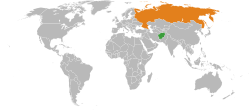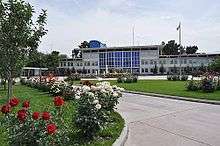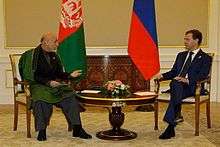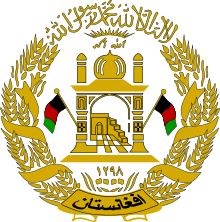Afghanistan–Russia relations
 |
|
Afghanistan |
Russia |
|---|---|
| Diplomatic Mission | |
| Afghani Embassy, Moscow | Russian Embassy, Kabul |


Afghanistan–Russia relations (Russian: Российско-афганские отношения) refers to the relations between the nations of Afghanistan and Russia. The Great Game is the story of Russian-British confrontations over Afghanistan since 1840.[1]
Relations were contentious when Soviet Russia invaded Afghanistan in 1979, precipitating a negative reaction in much of the Muslim world and creating a chain of events which would bring Afghanistan in the disastrous situation it finds itself now. However, Russo-Afghan relations have somewhat improved in the years following the conflict, and Russia now has an embassy in Kabul and a consulate-general in Mazar-e-Sharif, and Afghanistan has an embassy in Moscow.
Historical relations
Russian relations with Afghanistan have to be viewed with other Russian foreign relations because all foreign relations are involved with each other. Therefore, Russia and Afghanistan’s relations cannot be fully understood without knowledge of Russian-British relations and Russian-American relations. The Russian-British relations were strained because of the events of the Great Game, a time when every powerful nation tried to obtain as much land as possible, regardless of the benefits. Russian-American relations were defined by the actions of both nations during the Cold War.
In the nineteenth century, Afghanistan served as a strategic buffer state between Czarist Russian and the British Empire in the subcontinent during the so-called Great Game. Around the 1830s, Imperial Russia wanted to conquer Afghanistan because of the potential economic profit. Britain also lusted after Afghanistan. Since Britain was the primary superpower, any British growth would negatively effect Russian influence and strength. Russian Foreign Minister Count Nesselrode stated, “English industry…, would deprive us entirely of the benefits which it (claims) to reap alone and would cause… the produce of our manufacturers to disappear from all markets of Central Asia.”[2] Russian wanted to maintain a secret agreement with Afghanistan for regional influence but was undermined by the British. Before the Russian Ambassador Captain Vitkievich could formally meet with the Afghanistan ambassador Amir Khan, Amir Khan struck up negotiations with the British Ambassador Captain Barnes. Amir Khan wanted assurances that the British would aid in the recovery of Peshwar, a district that had been recently lost to the Sikhs, and assurances that the British would aid the Afghanistan people in any disagreements with the Russians.
The British rejected this offer because of their preexisting friendship with Maharaja Ranjit Singh who was the ruler of the Sikh and Amir Khan’s brother who was also aligned with the Sikhs. Amir Khan turned to the Russians for aid. After this treaty was signed, the British dethroned Amir Khan. Following his dethronement, Amir Khan’s son led uprisings that eventually brought about his father’s installment into power. Amir Khan would go on to rule Afghanistan for the next twenty years up until 1863. The First Afghan war in 1843 was fought between the British puppet regime in Afghanistan and local insurgents.[3]
Amir Ali, the son of Amir Khan, saw turmoil growing forty years after the First Afghan War and sought aid from the British government, with the same terms that his father sought out. After the same refusal that Amir Khan received, Amir Ali decided to seek out a treaty with Russia. Much like the First Afghan War, the Second Afghan War arose from these convoluted ties between Britain, Russia, and Afghanistan. After the British decided to declare war on the Russians, the Russians became wary and decided to negotiate for peace.[4]
Afghanistan's relations with Moscow became more cordial after the Bolshevik Revolution in 1917. The Soviet Union was the first country to establish diplomatic relations with Afghanistan in 1919[5] after the Third Anglo-Afghan war and signed an Afghan-Soviet nonaggression pact in 1921, which also provided for Afghan transit rights through the Soviet Union. Early Soviet assistance included financial aid, aircraft and attendant technical personnel, and telegraph operators.

The Cold War spanned from the 1950s to the 1990s and was full of conflict between America and Russia. The main superpowers waged war through proxies, or super allies, because any direct conflict with each other could result in nuclear war. The Cold War shaped the Russian mindset with regards to developing countries.
At the beginning of Soviet intervention in Afghanistan in 1953, the Soviet government had three main objectives. The first was to threaten the Iranian oilfields or put themselves in a position to do so in the coming years. The second goal was to strengthen influence in the Indian Peninsula. The last goal was divert western weapons to areas unproductive areas. All of these goals were aimed at long term gains.
Leading up to the Soviet intervention, Afghanistan’s policy was that of non-alignment, meaning they did not want a superpower ally. Even though they did not want to align themselves with any superpower, the Afghanistan government still retained good terms with both America and the Soviet Union. In 1958, Afghanistan’s prime minister Daud Khan tried to create a treaty with America against the Soviet Union because he was frightened of a potential Soviet invasion and because he needed modern weapons. After the Americans turned down the Afghanistan government, Afghanistan asked U.S.S.R. for aid in 1956. With this agreement, the Soviet Union provided financial aid, military personal training, and modern weapons, such as ak-47s and rocket launchers. Daud Khan was forced to resign in 1963 because of the dependence that he had created on the Soviet Union. After his brief resignation from office, Daud led a coup that toppled the Soviet’s puppet regime in Afghanistan which brought him back into power. To counteract his previous mishaps, Daud led Afghanistan back towards independence and non-alignment. Additionally, Daud sent troops as well as diplomats to surrounding nations to build up foreign relations, and decrease Afghanistan’s dependence on the Soviet Union.
There were four main motivations for the Soviet invasion in Afghanistan in 1979. First, the Soviets strategic importance of Afghanistan for security measures. Throughout Russian history, Russia has always been wary of neighboring countries and keeps their borders safe through expansion, or obtaining buffer states. The second reason was, the possibility of disrupting anti-Soviet nations, such as American and China. The third reason for invasion was to spread Marxist–Leninist revolutionary ideals. Lastly, the Soviets invaded for raw materials and inexpensive manufactured goods. These factors led to the Soviet invasion of Afghanistan in 1979. Around this time, the Soviets were also having success in other Middle Eastern areas, such as the Horn of Arabia and in the southern part of the Arabian Peninsula. The Soviet Union took almost universal condemnation after this invasion.[6]
The Soviets began a major economic assistance program in Afghanistan in the 1950s. Between 1954 and 1978, Afghanistan received more than $1 billion in Soviet aid, including substantial military assistance. In 1973, the two countries announced a $200-million assistance agreement on gas and oil development, trade, transport, irrigation, and factory construction. Following the 1979 invasion, the Soviets augmented their large aid commitments to shore up the Afghan economy and rebuild the Afghan military. They provided the Karmal regime an unprecedented $800 million. The Soviet Union supported the Najibullah regime even after the withdrawal of Soviet troops in February 1989. Today, unresolved questions concerning Soviet MIA/POWs in Afghanistan remain an issue between Russia and Afghanistan.
In 1993, Tajik rebels based in Afghanistan attacked a Russian border outpost in Tajikistan, killing 25 Russians and prompting Russian retaliatory strikes, which caused extensive damage in northern Afghanistan. Reports of Afghan support for the Tajik rebels led to cool relations between the two countries.
Russia became increasingly disenchanted with the Taliban over their support for Chechen rebels and for providing a sanctuary for terrorist groups active in Central Asia and in Russia itself. Russia provided military assistance to the Northern Alliance, who eventually proved a major force in the efforts to overthrow the Taliban regime following US intervention in 2001.
In October 2005, Russian defense officials stated they will be giving helicopters and other military equipment to Afghanistan's army worth $30 million USD.[7]
In October 2010, the Afghan President Hamid Karzai reprimanded Russia after its forces entered the country without permission. He also stated that Russia has "violated Afghan sovereignty" in a joint mission with United States agents.[8]
References
- ↑ Rodric Braithwaite, . "The Russians in Afghanistan." Asian Affairs 42.2 (2011): 213-229 summarizes the long history.
- ↑ Khalid, Mohammad. 1980. “RUSSIA'S INFLUENCE OVER AFGHANISTAN—STORY OF BRITISH FOLLIES”. Pakistan Horizon 33 (1/2). Pakistan Institute of International Affairs: 49–56. http://www.jstor.org/stable/41393621.
- ↑ Khalid, Mohammad. 1980. “RUSSIA'S INFLUENCE OVER AFGHANISTAN—STORY OF BRITISH FOLLIES”. Pakistan Horizon 33 (1/2). Pakistan Institute of International Affairs: 49–56. http://www.jstor.org/stable/41393621.
- ↑ Khalid, Mohammad. 1980. “RUSSIA'S INFLUENCE OVER AFGHANISTAN—STORY OF BRITISH FOLLIES”. Pakistan Horizon 33 (1/2). Pakistan Institute of International Affairs: 49–56. http://www.jstor.org/stable/41393621.
- ↑ Amin Saikal, Ravan Farhadi, Kirill Nourzhanov. Modern Afghanistan: a history of struggle and survival. I.B.Tauris, 2006. ISBN 1-84511-316-0, ISBN 978-1-84511-316-2. Pg 64
- ↑ Garg, J. P.. 1981. “RUSSIAN PENETRATION IN THIRD WORLD WITH SPECIAL REFERENCE TO AFGHANISTAN”. The Indian Journal of Political Science 42 (4). Indian Political Science Association: 72–84. http://www.jstor.org/stable/41855111.
- ↑ "Tourists flee devastated flood area". Chicago Tribune. 10 October 2005. Retrieved 27 December 2014.
Russia will supply Afghanistan's fledgling army with helicopters and equipment worth $30 million
- ↑ Los Angeles Times - Karzai denounces drug raid in Afghanistan
Further reading
| Wikimedia Commons has media related to Afghanistan - Russia relations. |
- * Adamec, Ludwig W. Afghanistan's foreign affairs to the mid-twentieth century: relations with the USSR, Germany, and Britain (University of Arizona Press, 1974).
- Braithwaite, Rodric. "The Russians in Afghanistan." Asian Affairs 42.2 (2011): 213-229 summarizes the long history.
- Braithwaite, Rodric. Afgantsy: The Russians in Afghanistan 1979-89 (Oxford University Press, 2013).
- Girardet, Ed. Afghanistan: The Soviet War (Routledge, 2012).
- Hopkirk, Peter. The great game: The struggle for empire in Central Asia (Kodansha Globe, 1994).
- McCauley, Martin. Afghanistan and central Asia: A modern history (Routledge, 2016).


